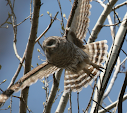
Saturday started off in Broomfield, as I checked out a group of retention ponds in the very northernmost bit of the City and County. There was a reported Glaucous Gull in the area, but I haven't found it in a pair of visits. That isn't saying much though, there are great numbers of gulls that spend their days moving between numerous ponds in the area and I may have just been missing it; and I am really bad with Gulls, so for all I know it may have been right there, or in one of the pictures that follow - but I doubt it. All of my gull IDs, or any bird for that matter, are open to correction or interpretation. I would like to learn after all, so if you see something that isn't quite right please feel free to comment or email. I will be sure to update as well if I find something as I become more experienced. With that disclaimer, I believe the airborne gull above is a third winter Herring Gull. It has pink feet, a distinct ring on its bill, dark primaries and a dark head.
Below, one of the birds is not like the others, that one is a second winter Thayer's Gull. It is large like a Herring Gull, which makes it stand out from the crowd. Here in Colorado the crowd consists of Ring-billed Gulls. The Thayer's in its second year is close in appearance to a Herring Gull of the same age, except the Thayer's Gull has lighter primary feathers. The primaries are the ones sticking out from the back of the bird to the left. They cover the tail, and in the Thayer's Gull are lighter and have a white border at the edge.

Another view of the Thayer's is below, but also included in that view is a possible 1st winter Ring-billed Gull. It seems a bit more brown than the depiction in my Sibley Guide to Birds, but that seems close to fitting. I am a bit baffled that I only found two birds that had that appearance. If they are first years shouldn't there be a few more running about?

Next up are a pair of Herring Gulls. The adult is on the left, isolated against the open water. The third year is on the right, with its wings folded back and up at an angle. The most notable difference between these two is the bill. The adult has the small red mark, showing only on its lower mandible, the third year still retains a black ring across both the upper and lower portions of its bill. Check out the pink feet on both of them! They can be good clues when there are hundreds of bodies huddled together and all of the heads are tucked. There is another, what I am calling, first year Ring-billed in this picture, can you find it?

Now on to gulls doing what gulls do when we humans don't feed them bread or trash. Again, please feel free to skip ahead if you faint when nicking a hangnail or wake up days after glancing at a sushi menu - really they aren't that bad - and if you've made it this far....
Even after looking through lots of pictures at pixelated zooms I can't tell if that is the gull's blood or it's lunch's. It was dunking its head repeatedly in an apparent attempt to rinse it, but it stayed fairly messy while I was there.
At first I thought the gull was injured, but then I got a look at a different section of the pond and was found it more likely that it wasn't. The Herring Gull below was working on a large fish. I had no idea that gulls could catch such large prey, but perhaps they drove a larger hunter away? At any rate this gull seemed to just be getting to the feast, and already had a bit of blood at the base of its bill. So many questions raised by a couple of gulls and a fish!

These ponds seem to be great concentrators for gulls and Common Mergansers (I counted 41 on Saturday's visit and 39 the week before). The are also small enough to allow me to get good looks and pictures to study without needing a scope. So perhaps with more visits I'll be able to say with certainty what types of gulls I saw.



Very nice series of shot of the gulls! They are birds I really enjoy seeing but rarely have the chance here.
ReplyDelete